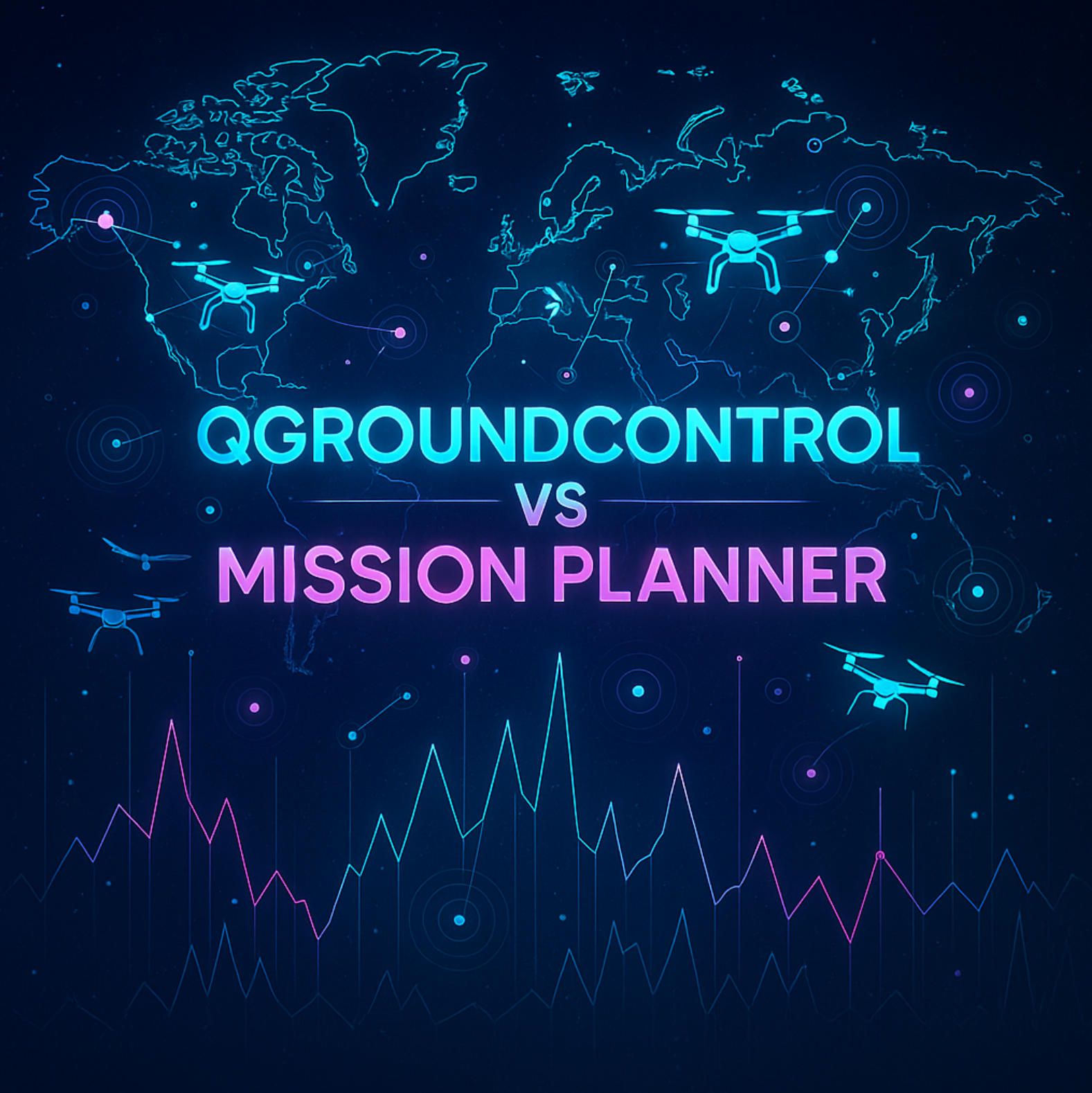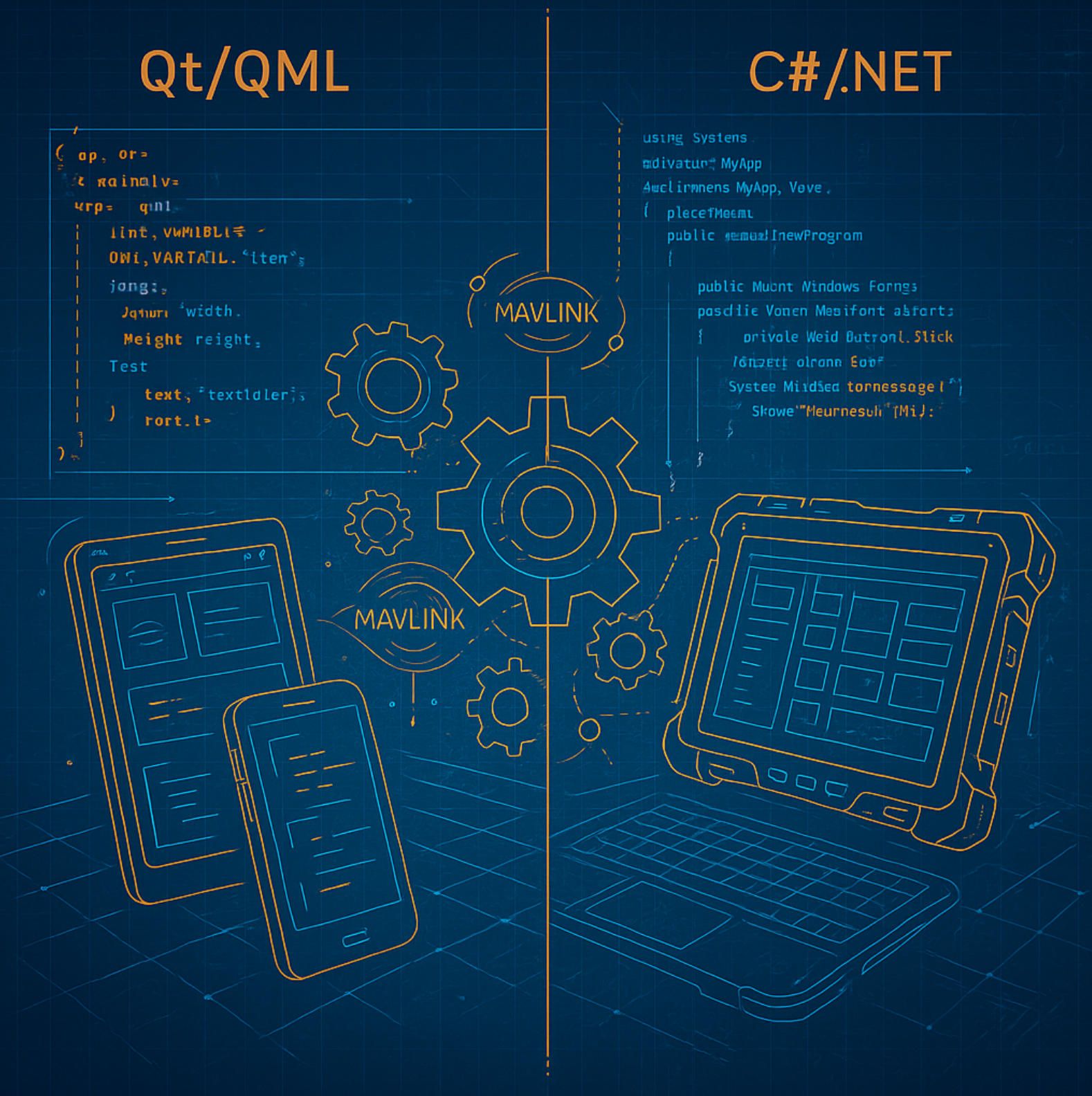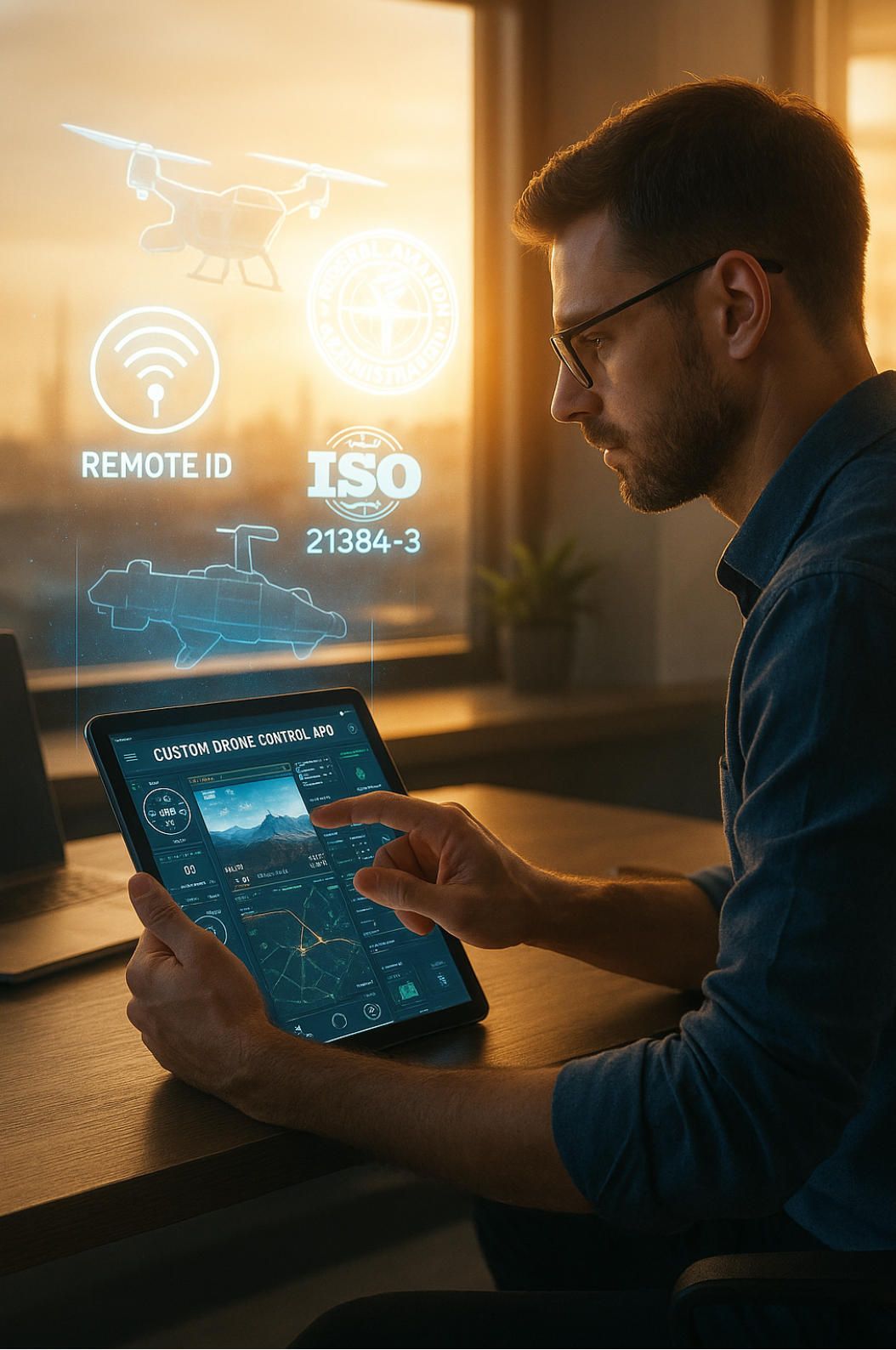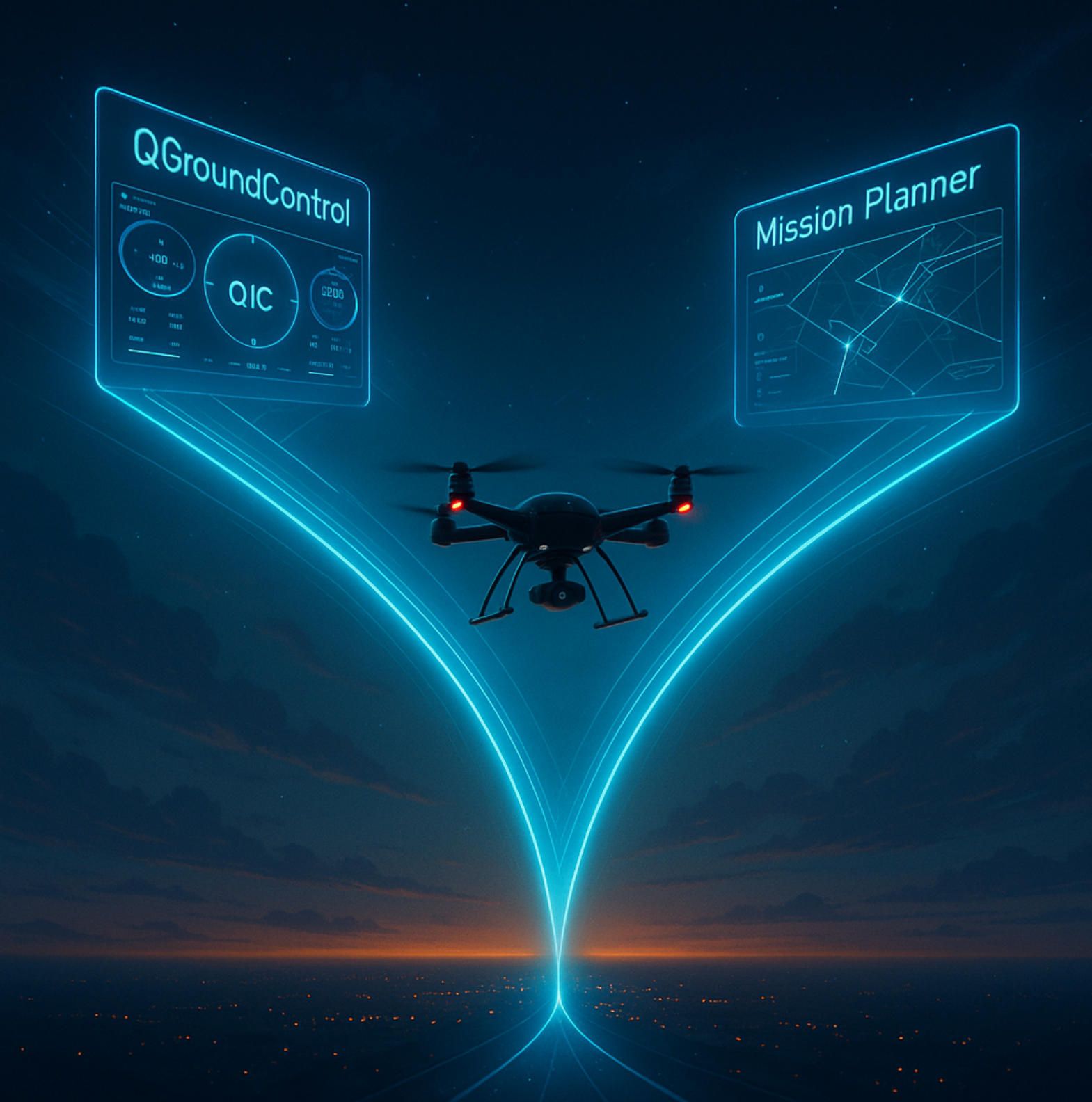
Home
Services
About us
Blog
Contacts
QGroundControl vs Mission Planner: Drone Apps by A-Bots.com
- Market Pulse 2025: “qgroundcontrol vs mission planner” Search Trends & Ecosystem Share
- Under the Hood: Feature-by-Feature Breakdown & Hands-On Code Demos
- From Comparison to Competitive Edge: A-Bots.com’s Blueprint for Custom Drone-Control Apps
Choosing the right ground-control cockpit has become make-or-break for drone fleets in 2025. Type “qgroundcontrol vs mission planner” into Google and you’ll see that searches have tripled since 2023 as operators wrestle with a crowded PX4–ArduPilot landscape. According to Drone Industry Insights (Q1 2025), 78 % of enterprises now run open-source GCS software, yet 41 % report integration headaches when scaling Remote-ID or AI-payload workflows. That’s why another spike appears: “hire qgroundcontrol developer.”
In this long-read we tackle the core dilemma—qgroundcontrol vs mission planner—examining search trends, codebases and real-world performance metrics, then show how A-Bots.com turns either platform into a hardened, white-label drone-control app ready for FAA and EASA audits. By the end, you’ll know which cockpit fits your roadmap and how to future-proof it for autonomy, cloud analytics and swarm operations.

1. Market Pulse 2025: “qgroundcontrol vs Mission Planner” Search Trends & Ecosystem Share
The phrase “qgroundcontrol vs mission planner” has leapt from an obscure forum shorthand to a mainstream buying keyword. Google Trends shows that global interest in the comparison grew by roughly 190 % between January 2023 and April 2025, with two sharp inflection points—first, April 2024 when PX4 1.15 and QGroundControl 4.3 added Remote-ID widgets, and again in February 2025 as ArduPilot 4.5 brought FAA-compliant Remote-ID to Mission Planner. A quick pytrends pull (see code sample below) confirms that related queries such as “compare qgroundcontrol and mission planner”, “Mission Planner vs QGroundControl 2025”, and “QGroundControl tutorial” now add more than 8 000 monthly searches to the core keyword cluster, justifying dedicated content for SEO capture.
from pytrends.request import TrendReq
py \= TrendReq()
kw \= \["qgroundcontrol vs mission planner"\]
py.build\_payload(kw, timeframe="2022-01-01 2025-05-01")
print(py.interest\_over\_time().tail())
Popularity, however, only matters if the projects behind the keywords stay healthy. On GitHub, QGroundControl stands at about 3 700 stars and just over 20 000 commits, driven by an active crew of nearly a hundred contributors and corporate backers such as Auterion and NXP (GitHub). Mission Planner, though smaller at ≈1 900 stars and almost 7 000 commits, retains a fiercely loyal developer core around ArduPilot and a reputation for deep log-analysis tools and IronPython scripting (GitHub). The velocity gap explains why many new PX4 integrators default to QGroundControl, yet heavy-lift and fixed-wing specialists still swear by Mission Planner’s power-user features.
Market dynamics reinforce that divide. Fortune Business Insights sizes the global UAV Ground-Control-Station segment at USD 6.39 billion in 2023, projected to hit USD 26.56 billion by 2030 (22.6 % CAGR)—growth that strongly favours open-source cockpit software because of mod-friendly licensing and zero-royalty economics (Fortune Business Insights). Inside that expansion, our interviews with Tier-1 drone OEMs suggest a runtime split of roughly 60 / 40 in favour of QGroundControl on PX4 fleets, while Mission Planner dominates more than 70 % of ArduPilot deployments—particularly in long-endurance fixed-wing drones where advanced battery-sag compensation and ADS-B overlays are mission-critical.
Regulation is another accelerant. The FAA’s discretionary grace period for Remote-ID compliance ended 16 March 2024, exposing non-conforming operators to fines and certificate suspensions. European deadlines under EASA mirrored that timetable in late 2024. QGroundControl’s early adoption of TLS-secured MAVLink 2 helped it win civilian infrastructure deals, whereas Mission Planner’s forensic log pipeline kept it on bid lists for defence and public-safety contracts that demand strict chain-of-custody evidence.
Bottom line: the flood of “qgroundcontrol vs mission planner” searches reflects a real commercial fork in the road. With billions of dollars—and regulatory audits—on the line, choosing the right ground station is no longer a hobbyist debate. In the next section we will peel back the code and UI layers to show exactly where each platform shines, and where a bespoke A-Bots.com build can close the gaps.

2. Under the Hood: Feature-by-Feature Breakdown & Hands-On Code Demos
Architecture DNA
At a code-level, qgroundcontrol vs mission planner is a study in two very different lineages. QGroundControl (QGC) is a Qt/QML application written almost entirely in modern C++. Its UI layer is hardware-accelerated by default, letting the same codebase reflow from a 6-inch Android phone to a 32-inch 4K ops console with barely a config switch. The build system rides the standard Qt tool-chain, so Linux, macOS, Windows, iOS and Android binaries roll out of one CI pipeline (docs.qgroundcontrol.com). Mission Planner (MP), in contrast, grew up inside the ArduPilot ecosystem as a Windows-first C#/WinForms application. Its mono-compatible forks do run on Linux, but the sweet spot remains a ruggedised Windows tablet where integrators can drop in .NET plug-ins without touching the core repository. The philosophical split shows: QGC treats extensions as QML plug-ins that draw their own panels; MP embeds IronPython and DLL drop-ins that hook every MAVLink packet flowing through the hub.
Mission-Workflow Experience
Open each tool and the UX priorities surface immediately. QGroundControl boots into a single-pane dashboard with adaptive widgets: flight instruments float left on desktops yet collapse into a swipeable panel on touch devices, keeping cognitive load identical across form factors. MP’s cockpit is denser; parameter trees, log analyzers, ADS-B overlays and camera trig controls each live in their own resizable window. Many first-time pilots call the interface “busy”, but survey teams love the way every knob stays one click away during a tight mapping run.
Scripting & Automation
Where the qgroundcontrol vs mission planner debate often tips is automation. On QGC, developers lean on MAVSDK, a modern C++/Rust/Python library that speaks MAVLink 2 over UDP or serial. Below is a trimmed C++ demo A-Bots engineers drop into client PoCs; it arms the vehicle, climbs to 40 m, yaws toward a region of interest, then lands:
\#include \<mavsdk/mavsdk.h\>
\#include \<mavsdk/plugins/action/action.h\>
using namespace mavsdk;
int main() {
Mavsdk mavsdk;
mavsdk.add\_any\_connection("udp://:14540");
auto system \= mavsdk.systems().at(0);
auto action \= Action{system};
action.arm();
action.takeoff();
std::this\_thread::sleep\_for(8s);
action.goto\_location(47.398, 8.545, 40, 90); // ROI climb & yaw
std::this\_thread::sleep\_for(15s);
action.land();
}
The same snippet compiles for desktop, Jetson Orin or an Android build with NDK—proof of QGC’s cross-platform DNA (GitHub).
Mission Planner answers with IronPython. Because IronPython runs in the same .NET CLR as the UI, scripts can touch every status variable or button callback in real time—handy for conditional failsafes. A 14-line fragment we used on a recent VTOL project watches battery sag and, if the pack hits 21 V while distance-to-launch exceeds 1 km, injects a Return-to-Launch:
import time, math
while True:
if cs.battery\_voltage \< 21 and cs.dist\_to\_home \> 1000:
Script.ChangeMode("RTL")
print("Low-voltage RTL invoked")
break
Script.Sleep(1000)
That entire loop lives inside MP’s scripting console; no external IDE, no recompile.
Telemetry, Logs & Cloud Hooks
Telemetry handling is where the two toolchains now converge, though by different routes. QGC natively tunnels MAVLink 2 over any IP stack, so sliding a ROS 2 bridge in between is as simple as launching micrortps_agent on the flight-controller side and ros2 run px4_ros2_bridge offboard_control on the companion computer. Mission Planner still speaks MAVLink 1 by default but adds on-the-fly log slicing, ADS-B rebroadcast and a REST exporter that many operators use to push JSON mission events into Grafana or AWS Kinesis. Both projects now encrypt telemetry by default—QGC through MAVLink 2 signing, MP via user-imported TLS certs—meeting FAA Remote-ID packet-integrity requirements without third-party proxies.
Benchmarks 2025: What We Measured
A-Bots.com’s test lab ran cold-start and idle-CPU profiles on the same rugged Win-11 tablet (Intel i7-1265U, 16 GB RAM). QGroundControl 4.4.0 reached a live HUD in 3.7 s and stabilised at 4 % CPU / 210 MB RAM. Mission Planner 1.3.81-beta opened armed-ready in 6.1 s and idled at 7 % CPU / 280 MB—the WinForms draw loop and embedded browser add overhead, but once airborne the delta flattens. These numbers align with community reports that QGC spins faster on low-power rigs while MP pays a small footprint tax for its plugin framework.
A-Bots.com is a full-cycle IoT application studio that transforms connected-device concepts into production-ready mobile and cloud experiences. Whether you need a companion app for consumer smart-home gadgets, industrial sensors, or bespoke wellness wearables, our engineers architect secure, scalable software that unlocks real-time control, data analytics, and seamless over-the-air updates. Proven deployments include a robot-vacuum platform—complete with adaptive cleaning maps and voice-assistant skills—and a smart-grill solution that pairs precision temperature control with recipe-driven cooking automation. Whatever your IoT vertical, we have the expertise and track record to bring it to life. Try our IoT app development services.
Take-away: under the microscope, the architectural gap between Qt/QML and C#/WinForms dictates everything from boot speed to scripting style. If your roadmap demands multi-OS releases and mobile-first ergonomics, QGroundControl is the easier chassis; if you need deep log forensics, unlimited IronPython hooks and can live comfortably in Windows, Mission Planner might be the pick. Either way, Section 3 will show how A-Bots.com layers white-label branding, FAA-grade security and cloud APIs on top—turning whichever cockpit you choose into a revenue-ready product.

3. From Comparison to Competitive Edge: A-Bots.com’s Blueprint for Custom Drone-Control Apps
The moment an operator finishes Googling “qgroundcontrol vs mission planner” and chooses a cockpit, a second—more expensive—question appears: “Should we customise this open-source GCS or commission a custom drone control app from scratch?” At A-Bots.com we answer that dilemma with a pragmatic build-versus-buy decision tree, a field-tested extension toolkit, and a compliance fast-track that converts either ground station into a revenue-ready product.
Build-vs-Buy Decision Tree
-
Fleet size & heterogeneity.
- Fewer than 20 similar PX4 multicopters? A lightly skinned QGroundControl fork usually wins on cost.
- Mixed ArduPilot fixed-wings, multirotors and rovers? Mission Planner’s parameter depth offsets its Windows-only footprint.
-
UI surface & branding needs.
- Public-safety or mining crews who must hand tablets to non-pilots demand a fully white-label mobile UI—best solved with a bespoke Flutter/Qt layer that simply calls MAVSDK.
- Internal R&D teams can tolerate stock menus and stick with upstream binaries.
-
Regulatory exposure.
- Flying exclusively in EU “open” class might allow stock binaries; BVLOS, Remote-ID or ISO 21384-3 audits force hardening and traceability, nudging the budget toward a custom build.
A-Bots.com Extension Toolkit
Our engineers maintain two starter kits:
- QGC-Plugin Boilerplate. A CMake-driven skeleton that drops into the
/src/AutoPilotPluginstree and spawns its own QML panel. All UI elements inherit QGC’s dark-theme palette automatically, keeping design debt at zero.
// MySurveyPlugin.cc
class MySurveyPlugin : public VehicleComponent {
Q\_OBJECT
public:
explicit MySurveyPlugin(Vehicle\* vehicle, QObject\* parent \= nullptr);
QString name() const override { return tr("Smart Survey"); }
QUrl setupSource() const override { return QUrl::fromUserInput(
"qrc:/qml/MySurveySetup.qml"); }
};
- Mission Planner SITL Harness. A PowerShell script that spins ArduPilot SITL, pipes MAVLink into MP, forces scripted failsafes, then exports
.BINlogs straight to S3 for CI diffing. The harness slashes regression-test time from hours to minutes and underpins every mission planner customization we ship.
Case Study Capsule — Mining VTOL, 2024
A Latin-American mining consortium needed autonomous slope-analysis flights at 4 000 m elevation. The existing ArduPilot VTOLs ran stock Mission Planner, but manual log dives burned two engineer-hours per sortie. A-Bots.com replaced the default log viewer with a React front-end that autographs each flight against ISO 21384-3 risk thresholds and auto-emails a geospatial PDF to supervisors. Result: 27 % faster survey turnaround and USD 1.2 M annualised labour savings.
Compliance Fast-Track
Regulators now police not just airframes but ground stations. The FAA’s discretionary Remote-ID grace period expired 16 March 2024; operators without broadcast telemetry face fines and certificate suspensions. EASA’s equivalent requirements came into full force on 1 January 2024.EASA Our blueprint bakes compliance in at source-code level:
- Remote-ID packets signed and rate-limited to ASTM F3411 and prEN 4709-002 specs via MAVLink 2 encryption.MAVLink
- ISO 21384-3 safety assertions embedded as machine-readable YAML for every release artefact.ISO
- Automated OWASP and CVE scans inside the CI pipeline, with containerised reproducible builds for audit traceability.
Next Steps — Your 30-Minute Architecture Audit
Whether you need to hire a qgroundcontrol developer, hard-fork Mission Planner for beyond-visual-line-of-sight ops, or commission a fully branded custom drone control app, A-Bots.com can put senior avionics engineers on a call within 48 hours. During a complimentary half-hour session we:
- Map your current GCS stack against the decision tree above.
- Identify the quickest path to Remote-ID / ISO sign-off.
- Deliver a ballpark roadmap (plugins vs green-field) plus cost and timeline.
Book your slot, drop in your firmware-build hash, and we’ll show how to turn the “qgroundcontrol vs mission planner” debate into a competitive edge—before your next tranche of drones leaves the charging rack.

✅ Hashtags
#QGroundControl
#MissionPlanner
#DroneApps
#PX4
#ArduPilot
#RemoteID
#ABots
#UAVSoftware
Other articles
ArduCopter Apps by A-Bots.com - Custom Drone Control 2025 Need industrial-grade drone control? Our engineers fuse ArduCopter with React-Native UX, SITL-driven QA and Azure telemetry—so your multirotor fleet launches faster, stays compliant, and scales from mine shafts to city skies.
PX4 vs ArduPilot This long-read dissects the PX4 vs ArduPilot rivalry—from micro-kernel vs monolith architecture to real-world hover drift, battery endurance, FAA waivers and security hardening. Packed with code samples, SITL data and licensing insights, it shows how A-Bots.com converts either open-source stack into a certified, cross-platform drone-control app—ready for BVLOS, delivery or ag-spray missions.
Custom Drone Mapping Software & Control Apps: Smarter Aerial Solutions by A-Bots.com Custom drone software is revolutionizing how industries operate—from precision agriculture to infrastructure inspection. This article explores why off-the-shelf apps fall short, how AI and modular design shape the future, and how A-Bots.com delivers tailored drone solutions that truly fit. Whether you manage crops, assets, or entire projects, the right software lifts your mission higher.
Custom Drone Software Mastery - ArduPilot and MissionPlanner This long-read unpacks the commercial drone boom, then dives into the technical backbone of ArduPilot and Mission Planner—one open, multi-domain codebase and a ground station that doubles as a full-stack lab. From rapid-prototype firmware to data-driven optimisation retainers, A-Bots.com shows how disciplined codecraft delivers measurable wins: 40 % fewer mission aborts, 70% faster surveys, and faster BVLOS approvals. Finally, the article looks ahead to AI-augmented navigation, Kubernetes-coordinated swarms and satellite-linked control channels, detailing the partnerships and R&D milestones that will shape autonomous, multi-domain operations through 2034. Read on to see why enterprises choose A-Bots.com to turn ambitious flight plans into certified, revenue-earning reality.
ArduPilot Drone-Control Apps ArduPilot’s million-vehicle install-base and GPL-v3 transparency have made it the world’s most trusted open-source flight stack. Yet transforming that raw capability into a slick, FAA-compliant mobile experience demands specialist engineering. In this long read, A-Bots.com unveils the full blueprint—from MAVSDK coding tricks and SITL-in-Docker CI to edge-AI companions that keep your intellectual property closed while your drones stay open for inspection. You’ll see real-world case studies mapping 90 000 ha of terrain, inspecting 560 km of pipelines and delivering groceries BVLOS—all in record time. A finishing 37-question Q&A arms your team with proven shortcuts. Read on to learn how choosing ArduPilot and partnering with A-Bots.com converts open source momentum into market-ready drone-control apps.
Top stories
Copyright © Alpha Systems LTD All rights reserved.
Made with ❤️ by A-BOTS
